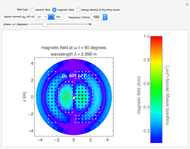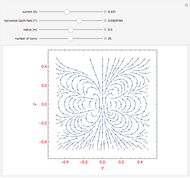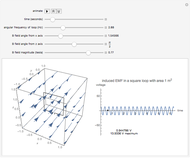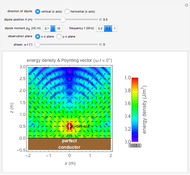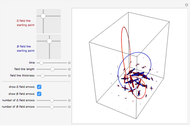Current-Carrying Wire in Uniform Magnetic Field

Requires a Wolfram Notebook System
Interact on desktop, mobile and cloud with the free Wolfram Player or other Wolfram Language products.
Consider an infinitely long cylindrical wire that carries a current  in the perpendicular uniform magnetic field
in the perpendicular uniform magnetic field  . This Demonstration shows the resultant field in the spaces both inside and outside the cylinder. Assume that the current density is constant in the cross section of wire and that the relative permeabilities
. This Demonstration shows the resultant field in the spaces both inside and outside the cylinder. Assume that the current density is constant in the cross section of wire and that the relative permeabilities  ,
,  inside and outside the cylinder are different. The directions of the applied field and wire current are the
inside and outside the cylinder are different. The directions of the applied field and wire current are the  and
and  axes, respectively. The field pattern is plotted in the
axes, respectively. The field pattern is plotted in the  -
- plane using color for strength and arrows for direction; the field intensity is normalized by
plane using color for strength and arrows for direction; the field intensity is normalized by  . You can vary the relative permeabilities, the applied magnetic field
. You can vary the relative permeabilities, the applied magnetic field  , the wire diameter
, the wire diameter  , and the wire current
, and the wire current  .
.
Contributed by: Y. Shibuya (October 2013)
Open content licensed under CC BY-NC-SA
Snapshots
Details
Snapshot 1: the 10mm-diameter nonmagnetic wire carries  (i.e.
(i.e.  ) in
) in  field
field
Snapshot 2: the 10mm-diameter nonmagnetic wire carries  (i.e.
(i.e.  ) in
) in  field
field
Snapshot 3: the 10mm-diameter ferromagnetic cylinder of  is in
is in  field
field
The resultant field both inside and outside the cylinder can be obtained considering the vector potentials of the uniform field  and the wire current
and the wire current  . As the result, the field is described in the following equations in cylindrical coordinates
. As the result, the field is described in the following equations in cylindrical coordinates  :
:
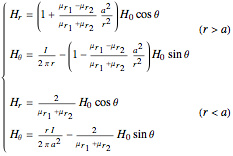 .
.
Here  is the radius of the cylinder (or
is the radius of the cylinder (or  , using a wire of diameter
, using a wire of diameter  ). The third component
). The third component  is zero. Those fields are transformed to Cartesian in the graphics displayed.
is zero. Those fields are transformed to Cartesian in the graphics displayed.
For Snapshots 1 and 2, the magnetic field at the wire surface due to the wire current  is calculated to be
is calculated to be  and
and  , respectively. Since
, respectively. Since  in those examples, they correspond to the cases
in those examples, they correspond to the cases  and
and  . The unsymmetrical field patterns suggest that an upward electromagnetic force should be generated.
. The unsymmetrical field patterns suggest that an upward electromagnetic force should be generated.
Snapshot 3 shows the effect of an outside magnetic field on the ferromagnetic material. According to the above equation, the field inside the cylinder is  , with direction along the
, with direction along the  axis, the direction of the applied field. The field intensity is very small since
axis, the direction of the applied field. The field intensity is very small since  .
.
Reference
[1] J. A. Stratton, Electromagnetic Theory, New York: McGraw–Hill, 1941.
Permanent Citation








